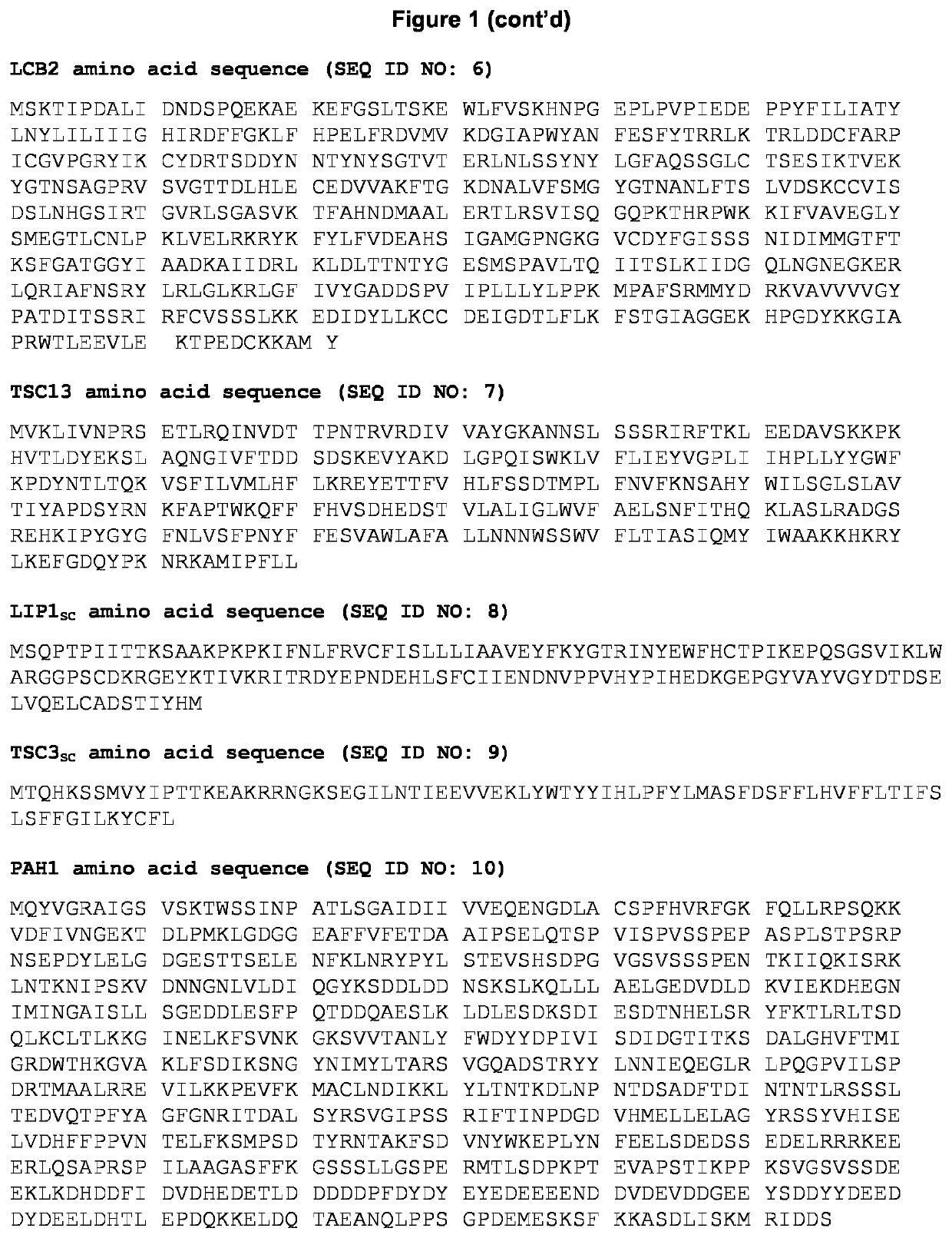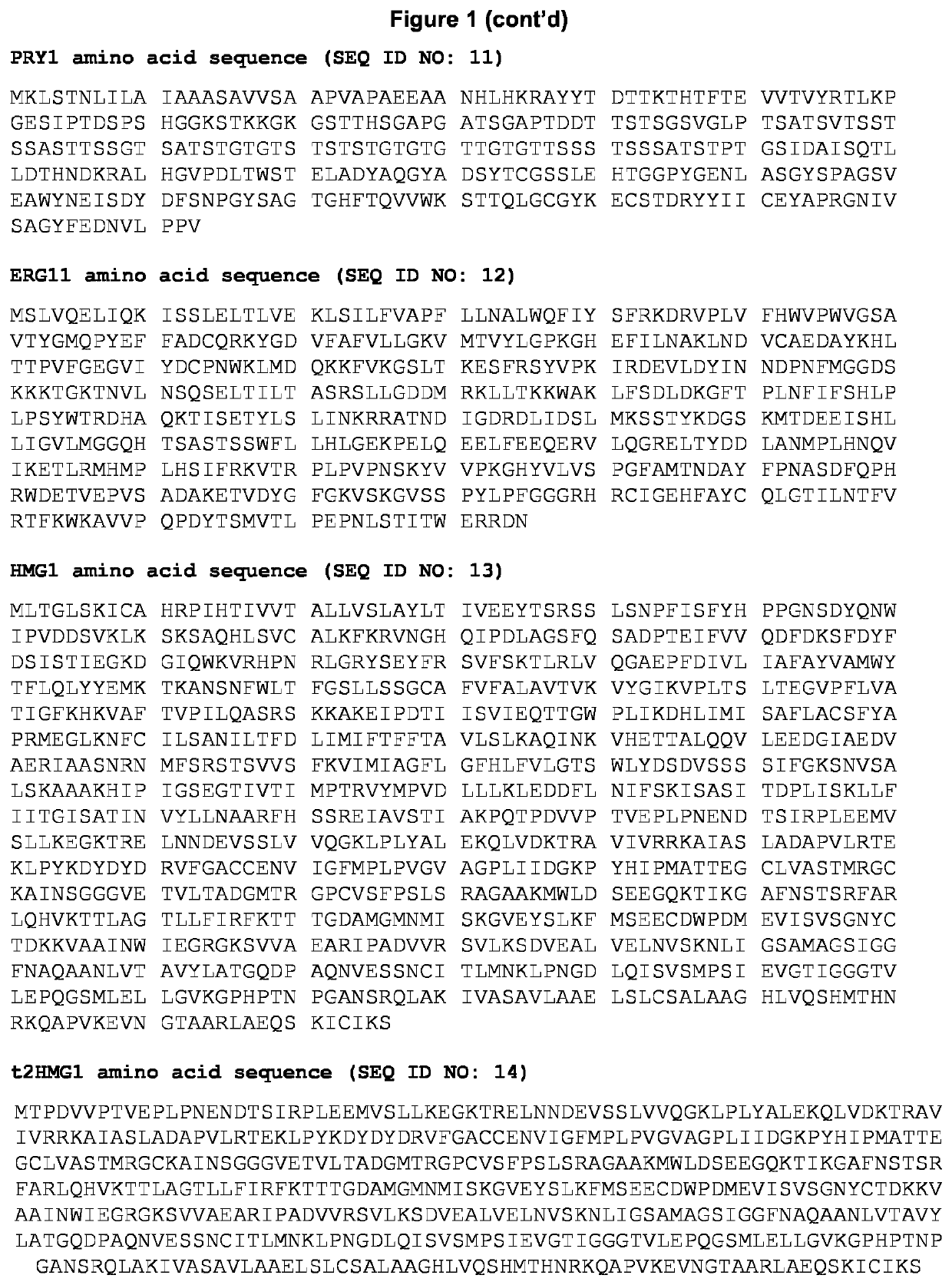Recombinant host cell with altered membrane lipid composition
a technology of host cells and membrane lipids, applied in the field of recombinant biotechnology, can solve the problems of limited heterologous protein synthesis, limited expression, and many other proteins only produced at comparatively low levels, and achieve the effect of improving the yield of poi and increasing the yield of protein
- Summary
- Abstract
- Description
- Claims
- Application Information
AI Technical Summary
Benefits of technology
Problems solved by technology
Method used
Image
Examples
example 3
n of Strains Overexpressing Target Genes
[0435]For the investigation of positive effects on Fab secretion, diverse proteins involved in lipid metabolism (see Table 1 herein) were overexpressed alone or in combination, or in combination with a chaperone in two different Fab producing strains: CBS7435 pPM2d_pAOX HyHEL and CBS7435 pPM2d_pAOX SDZ (generation see Example 1).
[0436]a) Amplification and Cloning of the Lipid Metabolism or Chaperone Genes into pPM2aK21 Expression Vectors
[0437]The genes overexpressed alone (Table 3; see results of Experiment 4 a-c) and in combination (Table 3 results of Experiment 6a) were amplified by PCR (Phusion Polymerase, ThermoFisher Scientific) from start (including initial 3 or 4 nucleotides of the authentic Kozak sequence) to stop codon using the primers shown in Table 3 and 5. Genomic DNA from P. pastoris strain CBS7435 muts served as a template (Table 3) except no corresponding coding sequence could be retrieved for wanted genes from sequence searche...
example 4
for Fab Expression
[0441]In small-scale screenings, 8 to 12 transformants of each overexpressing one gene (see Table 1 and 3) encoding a protein involved in lipid metabolism were tested in P. pastoris Fab production strain CBS7435 muts pAOX HyHEL-Fab. Transformants were evaluated by comparison to the parental host CBS7435 muts pAOX HyHEL-Fab which was co-transformed with the linearized empty vector (pPM2aK21) and ranked, based on their impact on cell growth, Fab titer and Fab yield.
[0442]A selection of genes encoding a protein involved in lipid metabolism were re-evaluated in the background of an additional host strain, CBS7435 mutS pAOX SDZ-Fab. Again, 8-12 transformants were tested in comparison to the parental host CBS7435 muts pAOX SDZ-Fab which was co-transformed with the linearized empty vector (pPM2aK21).
[0443]a) Small Scale Cultivation of Pichia pastoris Fab Production Strains
[0444]2 mL YP-medium (10 g / L yeast extract, 20 g / L peptone) containing 10 g / L glycerol and 50 μg / mL Z...
example 5
n of Strains Underexpressinq Selected Genes
[0453]P. pastoris POI production strains were engineered to comprise a knock out of a gene involved lipid biosynthesis pathway genes such as a gene involved in lipid storage. Selected were two genes encoding triacylglycerol synthases: dga1 (PP7435_Chr3-1009 (Table 1) and Iro1 (PP7435_Chr2-0587 Table 1)).
[0454]The P. pastoris Fab overproducing strain CBS7435 muts pAOX HyHEL-Fab was used as host strains. A split marker cassette approach was used as described by Heiss et al. (2013) [Appl Microbiol Biotechnol. 97(3):1241-9.] to generate transformants with a disrupted gene locus. Verification of positive knock-out strains was done by PCR, using genomic DNA of transformants which had been able to grow on G418 and primers outside of the disruption cassettes.
[0455]Table 5 lists all primers that were used for the construction of the knock-out cassettes (2 overlapping split marker cassettes per knock-out target): The primer pairs A_forward / A_backward...
PUM
| Property | Measurement | Unit |
|---|---|---|
| Fraction | aaaaa | aaaaa |
| Mass | aaaaa | aaaaa |
| Mass | aaaaa | aaaaa |
Abstract
Description
Claims
Application Information
 Login to View More
Login to View More - R&D
- Intellectual Property
- Life Sciences
- Materials
- Tech Scout
- Unparalleled Data Quality
- Higher Quality Content
- 60% Fewer Hallucinations
Browse by: Latest US Patents, China's latest patents, Technical Efficacy Thesaurus, Application Domain, Technology Topic, Popular Technical Reports.
© 2025 PatSnap. All rights reserved.Legal|Privacy policy|Modern Slavery Act Transparency Statement|Sitemap|About US| Contact US: help@patsnap.com



